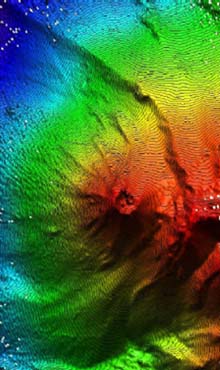
Morphology of Kick'em Jenny volcano, as revealed by a multi-beam survey by the NOAA Ship Ron Brown in March 2002. The survey shows that the modern cone of the volcano is nested within a larger horseshoe-shaped depression formed by slope failure.Click image for larger view.
Kick'em Jenny Submarine Volcano
March 10-21, 2003
Debby Kay, Web Coordinator
NOAA Research
Kick’em Jenny is the most active volcano in the Antilles Volcanic Arc. Since its debut eruption in 1939, it has provided scientists with a rare opportunity to learn about the growth and development of submarine volcanoes into eventual islands. NOAA’s Office of Ocean Exploration funded this mission to further investigate and evaluate the evolution of the volcano as well as its relationship to the natural environment surrounding the hydrothermal venting in the area. The mission was a collaborative effort among Professor John Shepherd (University of West Indies), Professor Haraldur Sigurdsson (University of Rhode Island (URI)), Professor Steve Carey (URI) and Dr. Doug Wilson (NOAA).
The mission began March 9, 2003, when the team met the NOAA research vessel Ronald H. Brown, in port at San Juan, Puerto Rico. It took most of that Sunday for the scientists to arrive and the better part of Monday to outfit the ship with stores and scientific equipment. But by 1800 hours that evening, we were underway at last. We slowly watched the shoreline fade as we headed for our final destination, the small submarine volcano called Kick’em Jenny, 7.5 km off the coast of Grenada. Although Kick‘em Jenny has been surveyed at least 11 times since 1962, and most recently by Dr Wilson on the Ronald H. Brown just prior to this cruise, this cruise was the most detailed study to date.
The scientists worked 12-hour shifts once onsite, using state-of-the-art equipment, such as multi-beam sonar, a specially equipped remotely operated vehicle (ROV), low intensity air guns, and conductivity-temperature-depth devices (CTDs), to conduct their multi-disciplinary research. They examined aspects of the submarine eruption style, looked for evidence of the type of magmatic evolution, hazards, the influence on biological activity around the vents, and potential hydrothermal mineralization. The first multi-beam scans of the area taken upon our arrival in the area March 12, showed new features of the volcano. It appeared that the modern cone of the volcano is nested within a larger horseshoe-shaped depression formed by past slope failure. Also revealed were several smaller craters.
In a post survey interview, the chief scientist on the project, Professor Haraldur Sigurdsson (URI), said, “We know of no historical eruptions from these craters. I suspect that they may be extinct. We will use chemical analysis of the rocks to tell whether these are separate volcanoes or not. If the rocks from the new craters are of the same chemistry as Kick‘em Jenny, then they are being fed from the same source. We will need to investigate this further.” One of the volcanoes has tentatively been named "Kick‘em Jack." There is no confirmation as yet that these craters were in fact separate "live" volcanoes.
One of the most spectacular views from the monitors on ship was of the ROV Oceanic Explorer approaching the main crater of Kick'em Jenny and coming up on a wall of gas bubbles. The discovery that Kick‘em Jenny was continuously releasing gas bubbles confirms the scientists’ previous beliefs that the volcano is actively degassing. It was important to discover just how much degassing was occurring with the volcano because this process can significantly lower the density of the water. This can be a serious danger to shipping or boating that would be occurring in the area.
Another exciting discovery for all was the multitude of biological samples found around the crater and vent sites. There were many scores of shrimp, polychaetes and other zooplankton collected for further study. Dr. Karen Wishner, a biological oceanographer at URI’s Graduate School of Oceanography, said that “there is quite a special biological community there, which is significant not just to Grenada but to international science because these are the first shallow vent communities found.” Shallow submarine active craters such as Kick‘em Jenny, have not been well studied in the past, and Dr. Wishner thought it was quite possible to find life forms here that would be unique and different from other vent communities.
All the scientists felt that they had collected much more data than originally anticipated and they hoped to publish their initial findings before the end of the year. A daily log with images from the cruise can be found on the University of West Indies' Web site ![]() . Its Seismic Research Unit is the primary agency responsible for monitoring the seismic activity throughout the English-speaking Eastern Caribbean.
. Its Seismic Research Unit is the primary agency responsible for monitoring the seismic activity throughout the English-speaking Eastern Caribbean.



